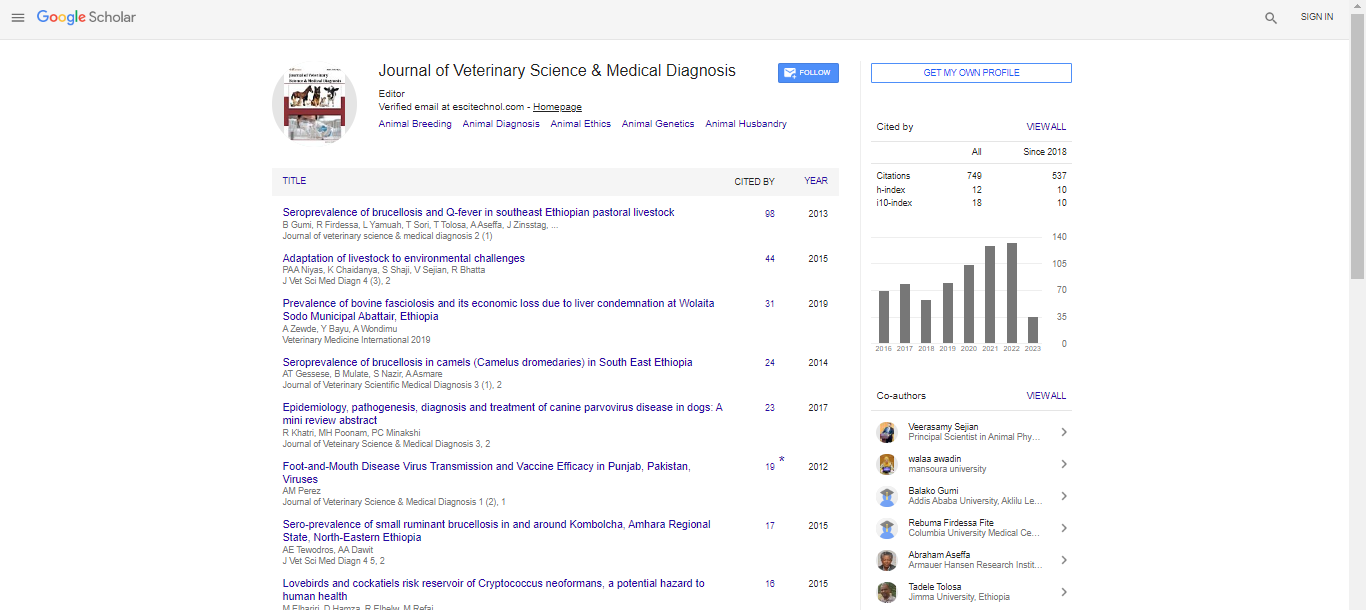Commentary, J Vet Sci Med Diagn Vol: 13 Issue: 2
Balancing Productivity and Resistance Risks in Animal Agriculture
Marie Chantal*
Department of Biological Sciences, Anchor University, Lagos, Nigeria
- *Corresponding Author:
- Marie Chantal
Department of Biological Sciences,
Anchor University,
Lagos,
Nigeria;
E-mail: marie@yahoo.com
Received date: 13 March, 2024, Manuscript No. JVSMD-24-154227;
Editor assigned date: 15 March, 2024, PreQC No. JVSMD-24-154227 (PQ);
Reviewed date: 29 March, 2024, QC No. JVSMD-24-154227;
Revised date: 09 April, 2024, Manuscript No. JVSMD-24-154227 (R);
Published date: 16 April, 2024, DOI: 10.4172/2325-9590.1000089
Citation: Chantal M (2024) Balancing Productivity and Resistance Risks in Animal Agriculture. J Vet Sci Med Diagn 13:2.
Description
Antibiotic resistance in animal agriculture is a growing concern that threatens both animal and human health. The use of antibiotics in livestock farming is essential for preventing and treating infections, promoting growth and enhancing productivity. However, the overuse and misuse of antibiotics have led to the development of Antimicrobial Resistance (AMR), which complicates treatment options for both animals and humans. The challenge now is finding a balance between maintaining high levels of productivity in animal agriculture and minimizing the risk of developing antibiotic-resistant pathogens. Achieving this balance requires careful management of antibiotic use, the development of alternative strategies and a commitment to long-term sustainable practices.
The primary driver of antibiotic resistance in animals is the extensive use of antibiotics in livestock production. Antibiotics are often used to treat bacterial infections, promote growth and prevent diseases in animals, particularly in intensive farming systems where animals are housed in close quarters. While antibiotics can improve livestock health and productivity by reducing mortality and enhancing growth rates, they also contribute to the selection and proliferation of resistant bacteria. These resistant bacteria can then spread to humans through direct contact with animals, consumption of animal products, or environmental contamination, creating a public health risk.
One key strategy to balance productivity and resistance risks is to adopt more responsible antibiotic use practices. This involves implementing antibiotic stewardship programs that focus on using antibiotics only when necessary and in the right doses. Veterinarians and farmers must work together to ensure that antibiotics are prescribed and administered correctly, following established guidelines and avoiding overuse or misuse. Additionally, the use of antibiotics as growth promoters in healthy animals has been banned in many countries, reducing the unnecessary use of these drugs. A targeted, evidence-based approach to antibiotic treatment that emphasizes prevention and precision medicine can help reduce the development of resistance.
In addition to optimizing antibiotic use, farmers can adopt alternative strategies to reduce the need for antibiotics and mitigate resistance risks. Improved animal husbandry practices, such as better sanitation, biosecurity measures and vaccination programs, can prevent the onset of infections, thereby reducing the need for antibiotic treatments. Rotational grazing, reduced stocking densities and better nutrition also contribute to healthier animals and lower the risk of disease outbreaks, the current and comprehensive antimicrobial usage practices in food animal production. By focusing on prevention, farmers can minimize their reliance on antibiotics while maintaining productivity.
Another promising approach to addressing antibiotic resistance is the development of novel treatments and alternatives to antibiotics. Additionally, vaccines are important in preventing infections that would otherwise require antibiotic treatment, reducing the need for antibiotics in the first place. These include the use of probiotics, prebiotics and antimicrobial peptides, which may help maintain animal health without contributing to resistance. The use of bacteriophages, viruses that target and kill specific bacteria, is also being known as a potential treatment for bacterial infections in livestock.
In conclusion, balancing productivity and resistance risks in animal agriculture is a complex challenge that requires careful management of antibiotic use and the integration of alternative strategies to reduce dependency on these drugs. Responsible antibiotic stewardship, preventive measures and innovation in treatment options will help ensure that livestock farming can remain productive and sustainable without compromising the health of animals or humans. Ultimately, achieving this balance is important to ensuring food security while protecting public health from the dangers of antibiotic resistance.
 Spanish
Spanish  Chinese
Chinese  Russian
Russian  German
German  French
French  Japanese
Japanese  Portuguese
Portuguese  Hindi
Hindi 
